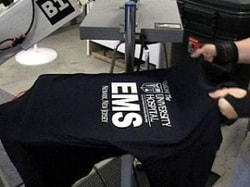 As a screen printer, are you familiar with the coating stroke? It is sometimes possible to eliminate flash curing on certain dark shirt orders. Think of how much time you can save if this technique will work for the job you may be printing. The mastery of an effective "coating" stroke may take some practice and will not work with all inks and every type of artwork or mesh count. But if you are able to use it on the job you are printing it could save you valuable time.  Smaller sized prints such as a left chest or sleeve prints are very good candidates for the coating stroke technique and trying out the technique on these smaller sized prints are usually the easiest and most successful. Often after printing and flashing the back of a shirt, you may be able to use the coating stroke for the front left chest. Compare the front print to the back and see if it appears to have an acceptably opaque print. If so, no need to flash. This can be a huge time saver especially if the order is for several hundred shirts. The coating stroke does not work all of the time. But with some single color print jobs (especially left chest size prints) and with certain inks it is possible to get an acceptable print with good opacity and eliminate the flash. The coating stroke's purpose is to just "cover over" a 1st or 2nd stroke to achieve an acceptably opaque print on a dark shirt without having to flash cure. A coating stroke uses about a 20-30 degree squeegee angle, similar to that of a flood stroke, however the stroke is usually applied with very light pressure causing the ink to gently "coat" over the existing print. The coating stroke works well with metallic and shimmer inks, super opaque transfer inks and certain brands of white inks. It is important to note that not all ink brands work equally well for the coating stroke technique. It will require a certain amount of trial and error and experimentation to see what works best. Moreover, lower mesh counts in the range of 140 mesh and lower will usually produce the best results as it is necessary to be able to drive a decent amount of ink through the screen. This article is written with the manual t-shirt printer in mind and the technique is for single color printing only.
0 Comments
Your comment will be posted after it is approved.
Leave a Reply. |
AuthorASPA Staff ArchivesCategories
All
|
Advice Notice & Disclaimers | Privacy Policy | Terms of Use | Sitemap | Contact Us | About ASPA | Advertise with Us | ASPA Members
Copyright © 2004-2024 American Screen Printing Association Inc. (ASPA) | The #1 Ranked Screen Printing Association on the Web | All Rights Reserved.
Copyright © 2004-2024 American Screen Printing Association Inc. (ASPA) | The #1 Ranked Screen Printing Association on the Web | All Rights Reserved.


 RSS Feed
RSS Feed